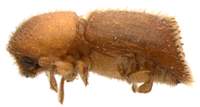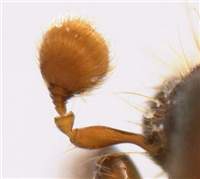Diagnosis
Elytral declivity truncated and surrounded by circular row of teeth. Scutellum missing, elytral bases covered with dense setae.
Similar to Microperus, but declivity sharply truncated. Similar to Webbia, but protibiae flat, not inflated posteriad, and pronotum of regular shape, not extremely elongated and obliquely rectangular in dorsal view.
Distribution
Palaeotropical, almost always rare.
Biology
The life history of Pseudowebbia is virtually unknown. Pseudowebbia are rare in collections, and presumably in nature.
Taxonomy
Included in Webbia in the Catalog by Wood & Bright (1992), resurrected by Hulcr et al. (2007).
Detailed description
Eyes deeply emarginate, sometimes almost disjunct, upper part smaller than lower part. Antennal club approximately circular, club type four (segment 1 small, second and third prominent on both sides). Segment 1 of club convex, small, margin of segment 1 mostly costate, may appear softer on posterior side, or mostly soft, pubescent. Segment 2 corneous on both sides of club, with sinuate edges, not circular. Segment 3 clearly visible on both sides of club. Segment 1 of antennal funicle shorter than pedicel, funicle 4-segmented, scapus regularly thick. Frons above epistoma mostly smooth, alutaceous, with minor punctures, or rugged, coarsely punctate. Submentum flat, flush with genae, or slightly impressed, shaped as very narrow triangle. Anterior edge of pronotum with no conspicuous row of serrations (serrations no different than on pronotal slope). Pronotum from lateral view of basic shape (type 0), or low and rounded (type 1), from dorsal view basic, short, parallel-sided, rounded frontally (type 2). Pronotal disc shining or smoothly alutaceous, with small punctures and dense setae, lateral edge of pronotum obliquely costate. Procoxae contiguous, prosternal posterocoxal process short and conical, or flat and inconspicuous. Tuft on pronotal basis associated with mesonotal mycangium absent, but setae on elytral bases associated with elytral mycangium abundant. Scutellum not visible. Elytral bases costate, straight or procurved. Elytral disc longer than declivity, flat, or impressed, "saddle-like", punctures on elytral disc confused. Elytral declivity sharply truncated, surrounded with arrays of tubercles. Circumdeclivital costa completely encircling declivity. Declivital surface covered with conspicuous thick scales, either erect and pointed or flat, or cushion-like. Protibia with evenly rounded edge, posterior side of protibia flat, no granules, only setae. Protibial denticles small or large, bases of denticles not enlarged, usually 7 or more protibial denticles present. Uniformly light brown, reddish, or dark brown. Length: 1.8-3.2 mm.



